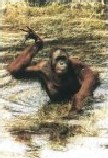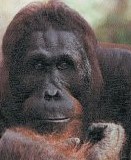Freedivers, readers of Deeper Blue and other devotees of the Aquatic Ape Theory (AAT) may be interested to learn that there are currently several science writers contributing to the debate on the aquatic genesis of mankind, some knowingly, and some not.
In The First Chimpanzee (Barnes & Noble Books, 2003) co-author John R. Gribben offers up a decent review of the basic AAT, mostly in the service of buttressing his main thesis: that chimpanzees, and their sister species the gorillas, diverged from the human line after it was already well on the way to human-ness. This makes you and me, as the title indicates, into ancestral chimps. Surprisingly, this isn’t as nutty as it sounds, and is somewhat supported (if not necessitated) by recent research in molecular dating, which has determined that humans and chimps split only 4-6 million years ago (MYA), though who did the splitting from whom is still up for debate. Perhaps divorce lawyers, rather than scientists, should handle this one.
Gribben and co-author Jeremy Cherfas touch on all sorts of interesting issues, such as the timing of a proposed aquatic phase in human evolution. Why, they also ask, did humans abandon the aquatic way of life if it was so successful? They also take issue with the traditional ladder of evolutionary progress, which always puts man at the top. All very heady stuff. Unfortunately, after tantalizing the reader with details of the aquatic theory, Gribben and Cherfas confess to a disagreement over it, and sideline the theory from the rest of their argument.
Two other books which aren’t about the AAT at all nevertheless contain ideas that give the theory a direct and reinvigorating jolt. They provide an answer to one of the most pernicious objections to the Aquatic Ape Theory, i.e., that there are no candidate ancestors among the living apes who don’t run screaming in fear from water.
The first book is The Red Ape: Orangutans and Human Origins by Jeffrey H. Schwartz (Westview Press, 2005) in which the author battles a veritable mountain of molecular evidence to insist that orangutans and humans share a direct common ancestor, thus pushing chimps out of the scientific limelight. But why should we care, aquatically speaking, if it’s orangutans who share a common history with us ?


The second book provides the "why", for if orangutans are our sister species, they share with us a fondness for water. Far from being afraid of it like chimps, wild adult orangutans have been observed wading across streams and willingly entering the water, walking upright, to splash and frolic. The Orangutans by Gisela Kaplan and Leslie J. Rogers (Perseus Books Group, 2000) points out that orangutans had to have crossed many large river systems to successfully colonize Borneo and Sumatra. The book also notes that the orangutan’s traditional and preferred habitat is always lowland with water easily accessible nearby. Only human encroachment has forced them onto higher, dryer ground. Similarly, in Orangutans: Wizards Of The Rain Forest by Anne E. Russon (Firefly Books Ltd,2004) there is a picture (p. 30) of a young adult orang mucking about in a pond, followed by a heartrending photo (p. 62) of abandoned infants at the Camp Leakey rehabilitation sanctuary in Borneo getting a ride to the river in a wheelbarrow for their bath and play time.
Combine these images of water-loving orangutans with the fact that they periodically walk bipedally when the mood suits them, and one can begin to picture the sort of Miocene era (12-8 MYA) primate Elaine Morgan had in mind for an aquatic interlude leading to. . .us, and, the similarities between orang and human listed in The Red Ape begin to look really significant.
First, the exciting stuff.
Unique among primates (except man), orangutans have abandoned an estrus cycle. Rather than coming into heat, with obvious ano-genital swelling to advertise the fact (which causes absolute mayhem in chimp colonies), female oranges have a regular menstrual cycle uncannily close to ours (28.4 vs 27.3 days). They engage in sexual activity throughout the month, and form consortships that last several weeks and may be repeated by the same pair year after year. Make no mistake – this “loss” of estrus represents a crucial biochemical and behavioural shift. In humans the “hiding” of estrus, and the move to continuous sexual receptivity, are seen as key requirements for evolving large cooperative social groups. With orangutans as our relational forebears, we don’t have to explain how hominids made the huge leap from a testosterone-charged male-dominated social system (chimps) to pair bonding. [Editor’s Note: Certain university campuses may yet prove exceptions to the explanatory power of the orantugan-ancestry model.]
I can hear some people in the balcony shouting “What about bonobos chimps??”, and with apparent good reason. Bonobos’ sexuality has become notorious for its frenetic, ubiquitous “everybody doing it to everyone” quality, that echoes somewhat uncannily our own obsession with things sexual. However, many primate researchers discount the comparative significance of the pan-sexuality of bonobos, because, you see, their pairings are mostly same-gender, and aren’t really sex at all, but social techniques for defusing aggression. It’s as if genital rubbing replaced the handshake as the common currency of social greeting. [Editor’s Note: See previous Editor’s Note] Bonobos’ actual male-female mating sessions are just as perfunctory as regular chimps, clocking in at a soul-stirring 8-10 seconds.
Orangutan sex, on the other hand, tends to be a fairly leisurely affair, with lots of touching with fingers and lips. Females initiate foreplay and sex, and mating is often face to face. If pregnancy results, gestation is about 270 days or nine months (sound familiar?) During pregnancy, both orangs and humans excrete 4-5 times more estriol than the African apes. Estriol in humans is correlated with proper fetal brain growth, which begs the question of what it’s doing for orangs.
But hey, do orangutans actually show the potential to have evolved into big-brained reasoning beings like us? Well, in the wild, orangutans have been observed to utilize what tools they have in very chimp-like ways. They use sticks to break things open, dig holes, reach for and snag branches to swing on, stir liquids, knock insects off their fur, and even hit each other on the head. But it’s in rehabilitation centres that they really get the chance to show off. They use hammers and saws, sweep pathways and strum guitars. In fact, they show almost limitless ability and desire to learn human behaviours by imitation, and sometimes for their own good reasons: one wild orangutan laboriously dismantled his cage when a screwdriver was accidentally left within reach.
As researchers spend more time with these often-overlooked apes, it’s becoming clear that they do more than just imitate – they solve problems. One orangutan in Camp Leakey stole a small boat, paddled across a stream, held onto the rope while he foraged, and then paddled back again, showing an awareness of how boats behave in streams, and clear foresight in securing the boat for the return voyage. In the lab, orangs beat out all other primates, chimps included, in problem solving, and do so even when no reward is offered, just for the thrill of it. Stranger still, they don’t seem to use simple trial and error as chimps do. Orangs will retreat from a perplexing problem, spend time glancing back at it, and then suddenly rush forward with the correct strategy. For me, the most telling story was of a female orang who became obsessed with fires, and mastered a complex, multi-step procedure for lighting them. Curious, persistent, devious and driven, something like some other species I know. [Editor’s Note: Deeper Blue’s demographic appears to have a significant orangutan segment.]
Most of what we share with chimps can be explained as general primate morphology, but humans and orangutans share several unique “derived” features that our supposed sister clade (chimp and gorilla) do not. Things like extra holes in the base of the skull, the widest placement of nipples on the female chest, and rounded rather than bar-like brow ridges. We share the growth of long hair, and teeth with low cusps and extremely thick dental enamel.
I realize that teeth may seem the height of boredom, but be assured that dental records are what really set palaeontologist hearts aflutter. Some fossil humans are only known from their teeth, and subtle changes in dentition mark the gossamer line between human and ape. This line has had to be hastily re-drawn several times, since confusion between homo and orang ancestors has long bedevilled anthropologists. As soon as molecular dating placed the human-chimp split at roughly 5 MYA, a whole slew of early hominoids were hurriedly re-classified as early orangutans. Ramapithecus, long seen as a midpoint between ape and homo (and because of their human-like teeth, probably closer to homo) has lost its former human ancestor status, and has now been relegated to the orangutan line. In fact, modern orangutan skulls look so identical to early human fossil skulls (like Lucy the upright–walking Australopithecine) that the infamous Piltdown forgery was based on an orangutan jaw, and managed to fool the scientific establishment for four decades.
So, there you have it – an ideal Miocene Era ancestor just primed to enter the water and be transformed into us.
But wait – there’s a fly in the aquatic ointment. If Elaine Morgan’s aquatic period is 12-8 million years ago, it predates the split between humans and chimps which occurred only 5 MYA. So why don’t chimps retain any aquatic adaptations? (The jaunty ragtime music grinds to a halt). Well, chimps have developed certain newer “derived” features since the split with us – exciting things like knuckle-walking, but they share these only with gorillas. And they show none, not one, of our snazzy water-adapted features like a fleshy nose, subcutaneous fat or descended larynx.


Damn. Without meaning to, the microbiologists doing DNA molecular dating have wrought havoc with our beloved aquatic ape theory. The only way to save it is to postulate that after the chimp-ape line split from humans, the group that would become homo had a sea-change. But does that leave enough time for natural selection to produce all the fancy adaptations that we show? Is there any corroborating evidence for a late aquatic period? Are people descended from aquatic apes or not, already ?
Tune in for the next installment of “Lucy in the Swamp with Molluscs”.
